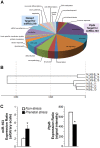Maternal stress induces epigenetic signatures of psychiatric and neurological diseases in the offspring
- PMID: 23451123
- PMCID: PMC3579944
- DOI: 10.1371/journal.pone.0056967
Maternal stress induces epigenetic signatures of psychiatric and neurological diseases in the offspring
Abstract
The gestational state is a period of particular vulnerability to diseases that affect maternal and fetal health. Stress during gestation may represent a powerful influence on maternal mental health and offspring brain plasticity and development. Here we show that the fetal transcriptome, through microRNA (miRNA) regulation, responds to prenatal stress in association with epigenetic signatures of psychiatric and neurological diseases. Pregnant Long-Evans rats were assigned to stress from gestational days 12 to 18 while others served as handled controls. Gestational stress in the dam disrupted parturient maternal behaviour and was accompanied by characteristic brain miRNA profiles in the mother and her offspring, and altered transcriptomic brain profiles in the offspring. In the offspring brains, prenatal stress upregulated miR-103, which is involved in brain pathologies, and downregulated its potential gene target Ptplb. Prenatal stress downregulated miR-145, a marker of multiple sclerosis in humans. Prenatal stress also upregulated miR-323 and miR-98, which may alter inflammatory responses in the brain. Furthermore, prenatal stress upregulated miR-219, which targets the gene Dazap1. Both miR-219 and Dazap1 are putative markers of schizophrenia and bipolar affective disorder in humans. Offspring transcriptomic changes included genes related to development, axonal guidance and neuropathology. These findings indicate that prenatal stress modifies epigenetic signatures linked to disease during critical periods of fetal brain development. These observations provide a new mechanistic association between environmental and genetic risk factors in psychiatric and neurological disease.
Conflict of interest statement
Figures




References
-
- Weerth C de, Buitelaar JK, Mulder EJH (2005) Prenatal programming of behavior, physiology and cognition. Neurosci Biobehav Rev 29: 207–208.
-
- Owen D, Andrews MH, Matthews SG (2005) Maternal adversity, glucocorticoids and programming of neuroendocrine function and behaviour. Neurosci Biobehav Rev 29: 209–226. - PubMed
-
- Champagne FA, Meaney MJ (2006) Stress during gestation alters postpartum maternal care and the development of the offspring in a rodent model. Biol Psychiatry 59: 1227–1235. - PubMed
-
- Champagne DL, Bagot RC, van Hasselt F, Ramakers G, Meaney MJ, et al. (2008) Maternal care and hippocampal plasticity: evidence for experience-dependent structural plasticity, altered synaptic functioning, and differential responsiveness to glucocorticoids and stress. J Neurosci 28: 6037–6045. - PMC - PubMed
Publication types
MeSH terms
Substances
Grants and funding
LinkOut - more resources
Full Text Sources
Other Literature Sources
Medical

